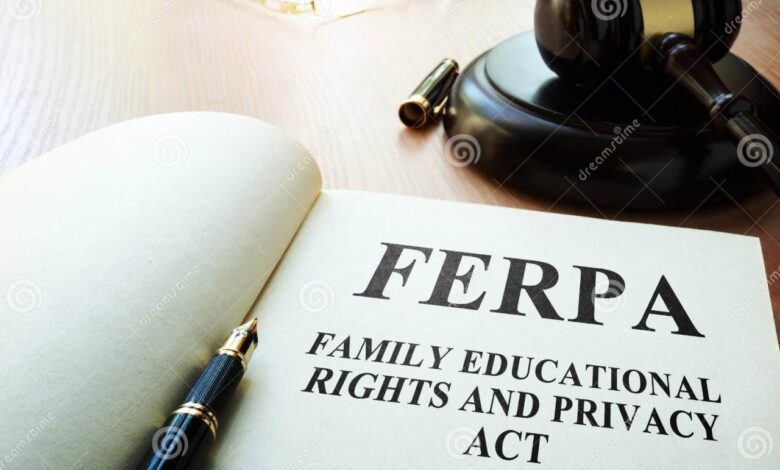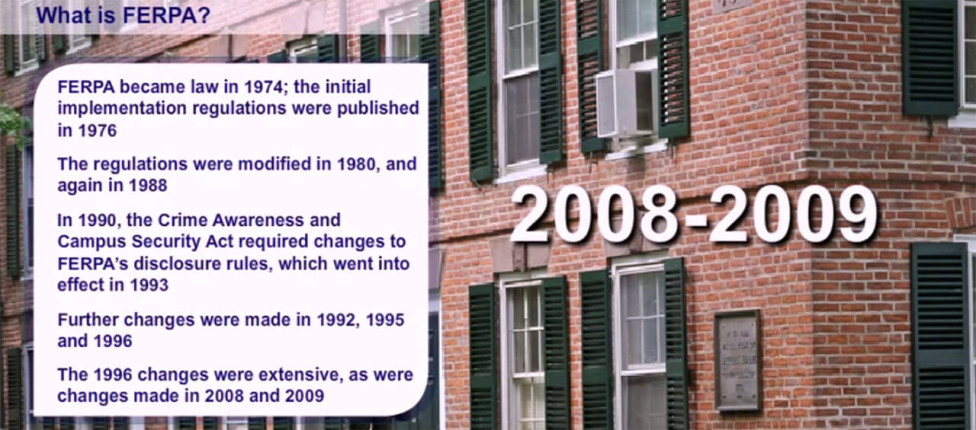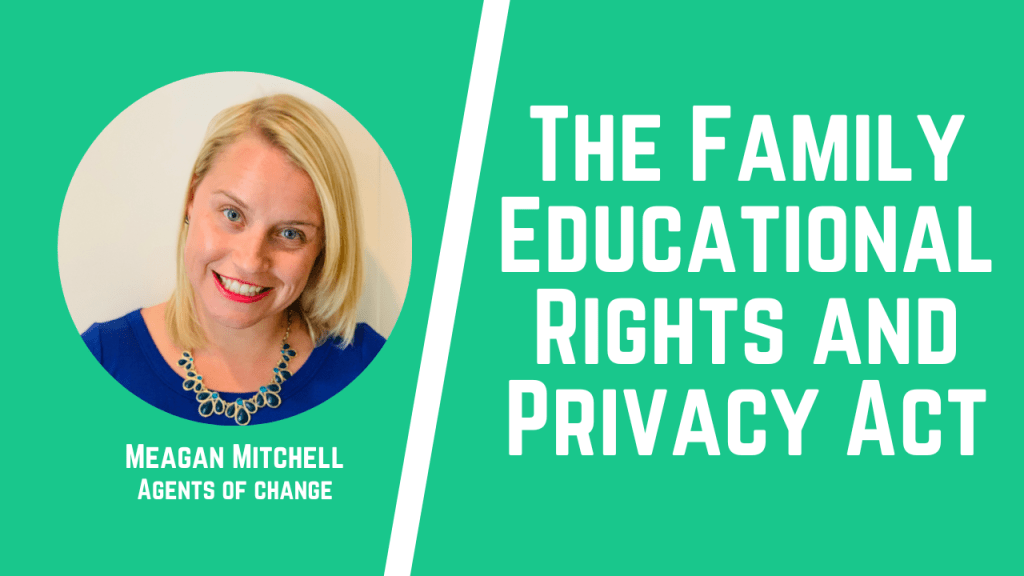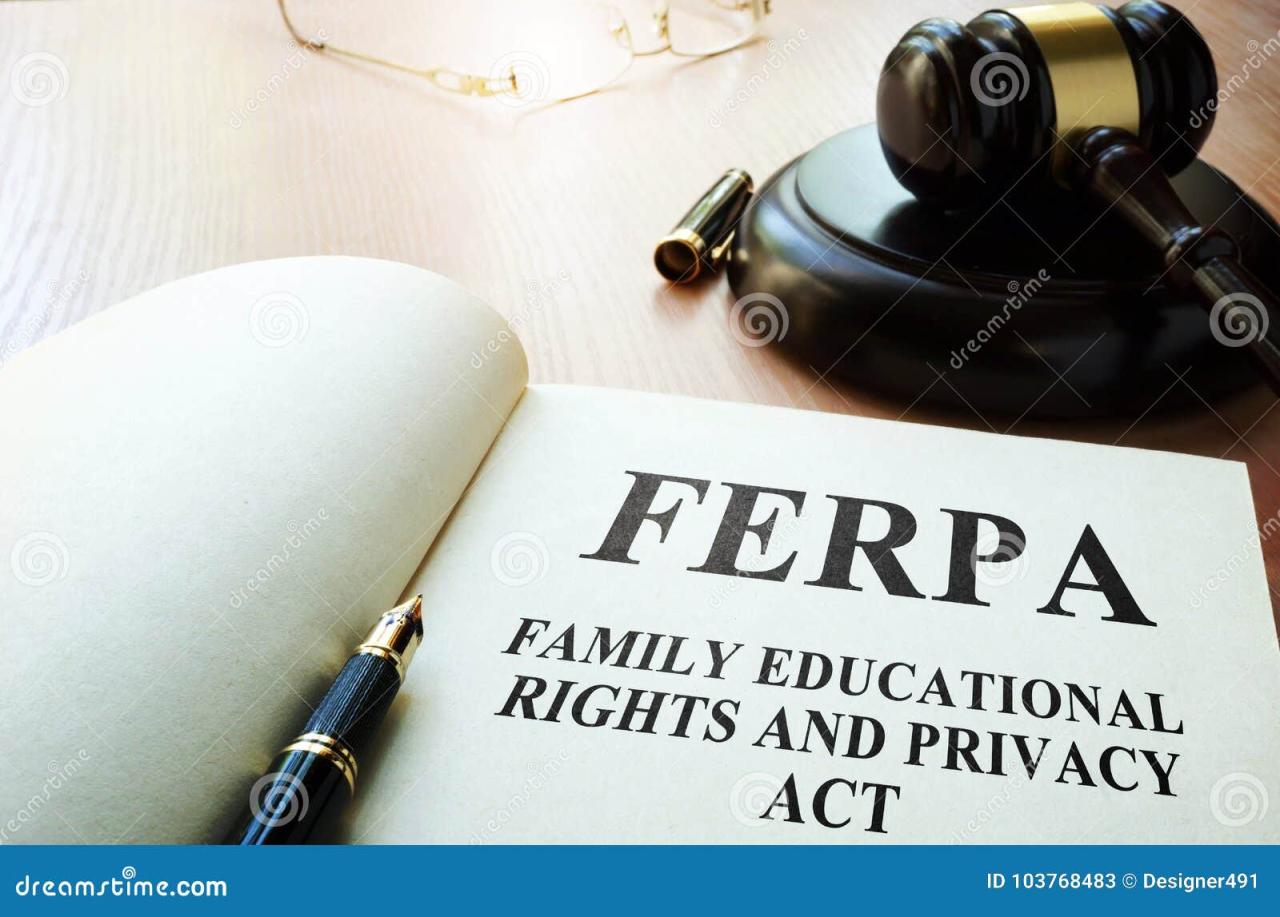
Guide to FERPA Compliance for Schools
Guide to FERPA compliance for schools: Navigating the often-confusing world of student privacy laws can feel like a daunting task for educators. This guide aims to demystify the Family Educational Rights and Privacy Act (FERPA), offering practical advice and clear explanations to help schools ensure they’re protecting student data effectively and responsibly. We’ll explore everything from record-keeping best practices to the nuances of third-party access, ensuring you feel confident in your approach to FERPA compliance.
Understanding FERPA isn’t just about avoiding legal trouble; it’s about fostering trust with parents and students, building a culture of responsible data handling, and ultimately creating a safer and more supportive learning environment. Let’s dive in and make sense of this vital legislation together!
Understanding FERPA Basics
FERPA, the Family Educational Rights and Privacy Act, is a federal law protecting the privacy of student education records. It’s crucial for schools to understand and comply with FERPA to safeguard student information and maintain trust with parents and students. This section will break down the key provisions of FERPA, outlining the rights granted and the responsibilities schools must uphold.
Key Provisions of FERPA
FERPA grants parents of eligible students and eligible students themselves specific rights concerning their educational records. These rights include the right to inspect and review the records, request amendments to inaccurate information, and control the disclosure of personally identifiable information. Schools must adhere to strict guidelines regarding record-keeping, access, and dissemination of student data. Failure to comply can result in the loss of federal funding.
The law also dictates procedures for handling requests for access and amendments, ensuring a transparent and accountable process.
Rights Afforded to Parents and Eligible Students
Parents of eligible students (generally those under 18) have the right to access their child’s education records, request amendments to incorrect information, and control the disclosure of those records. Once a student turns 18 or attends a post-secondary institution, these rights transfer to the student. This transfer of rights ensures that students have control over their own educational information as they mature and progress in their academic journey.
Parents or eligible students can exercise these rights by submitting a written request to the school’s designated FERPA official.
Definition of Directory Information and its Implications
Directory information is defined as information that a school may generally disclose without consent. Common examples include a student’s name, address, telephone number, date and place of birth, major field of study, dates of attendance, degrees and awards received, and participation in officially recognized activities and sports. However, schools must provide parents and eligible students with an annual opportunity to opt out of having any or all of this information released.
This opt-out provision is crucial for protecting student privacy and ensuring that schools respect individual preferences. The school must clearly inform parents and eligible students about their right to opt out and how to do so.
Examples of Information Protected Under FERPA
Many types of student information are protected under FERPA. This includes academic records (grades, transcripts, disciplinary actions), health records (medical information, counseling notes), financial aid information, and any other personally identifiable information directly related to the student. Test scores, individual evaluations by teachers, and special education records are all specifically protected. The disclosure of such information without consent is a violation of FERPA and can have serious consequences for the institution.
Schools must implement robust security measures to prevent unauthorized access and disclosure of these sensitive records.
Comparison of FERPA Rights for Parents and Eligible Students
| Right | Parent of Eligible Student | Eligible Student |
|---|---|---|
| Access to Records | Yes | Yes |
| Request Amendment | Yes | Yes |
| Control of Disclosure | Yes | Yes (once eligible) |
| Consent for Disclosure | Required unless directory information | Required unless directory information or other exceptions apply |
FERPA Compliance in School Records Management

Maintaining accurate and secure student records is paramount for any educational institution. The Family Educational Rights and Privacy Act (FERPA) dictates strict guidelines for how schools handle this sensitive information, impacting everything from record creation to eventual disposal. Understanding these requirements is crucial for ensuring both legal compliance and the protection of student privacy.
Accurate and Secure Student Record Maintenance
FERPA requires schools to maintain accurate and readily available student records. This includes ensuring that all information is current, complete, and free from errors. Schools must establish procedures for updating records promptly when changes occur, such as address updates or changes in emergency contact information. Security measures are equally vital. Records must be stored in a secure location, accessible only to authorized personnel.
This might involve physical security measures like locked filing cabinets and password-protected digital databases, along with robust data encryption protocols for electronic records. Regular audits and training for staff on data security best practices are essential components of a robust FERPA-compliant system.
Procedures for Handling Student Record Requests
FERPA grants students (or their parents, if the student is a minor) the right to inspect and review their educational records. Schools must establish clear procedures for handling these requests, including specifying the timeframe for fulfilling them (typically within 45 days). The process should be transparent and easily accessible to students and parents, often detailed in a school handbook or on the school’s website.
Furthermore, schools must provide parents and eligible students with a copy of their rights under FERPA. This ensures transparency and empowers individuals to exercise their rights effectively. Requests for record amendments must also be handled according to specific procedures, allowing for the review and potential correction of inaccurate or misleading information.
FERPA’s Implications on Record Retention Policies
FERPA doesn’t explicitly dictate record retention periods, but schools must maintain records for a reasonable period consistent with their needs and state/local laws. This period might vary depending on the type of record. For instance, transcript records are typically retained indefinitely, while some disciplinary records might have shorter retention periods. However, regardless of the retention period, all records must be securely stored and disposed of in a manner that protects student privacy.
Destruction of records should follow a secure process, preventing unauthorized access or disclosure.
Sample FERPA-Compliant Record-Keeping Policy
A sample policy might include:
- Record Accuracy: All records will be kept accurate and updated regularly. Staff will be trained on data entry and record maintenance procedures.
- Access Control: Access to student records will be restricted to authorized personnel only, using secure passwords and access controls. Regular audits will be conducted to ensure compliance.
- Record Requests: Procedures for handling requests for student records will be clearly defined and readily available. Requests will be processed within 45 days.
- Retention Policy: Specific retention periods for different record types will be established, in accordance with state and local laws. Secure disposal methods will be followed.
- Data Security: All electronic records will be encrypted and protected by firewalls and other security measures. Staff will receive regular training on data security best practices.
This policy should be regularly reviewed and updated to reflect changes in FERPA regulations and best practices.
Potential FERPA Violations in Record Management
Potential violations include unauthorized access to records, failure to comply with record requests, inaccurate or incomplete records, and improper disposal of records. For example, leaving student records unattended in a public area, releasing information to unauthorized individuals (e.g., a parent requesting information about another student), or failing to correct inaccurate information in a timely manner would constitute a violation.
Schools must proactively work to prevent these violations through comprehensive training, robust security measures, and a culture of compliance.
FERPA and Student Data Privacy in Technology
The digital age has revolutionized education, bringing with it powerful learning tools and vast amounts of student data. However, this increased reliance on technology also presents significant challenges to FERPA compliance. Schools must navigate a complex landscape of online platforms, cloud services, and data security protocols to ensure the privacy and protection of student information. Understanding the FERPA implications of educational technology is crucial for maintaining compliance and safeguarding student rights.
FERPA Implications of Educational Technology
Educational technologies, including Learning Management Systems (LMS) like Canvas, Blackboard, and Moodle, store and process significant amounts of student data, ranging from grades and assignments to personal information and communication records. FERPA requires schools to protect this data with appropriate safeguards. The use of any technology that collects, stores, or transmits student information must adhere to FERPA’s stipulations regarding parental consent, data security, and access restrictions.
Failure to do so can result in serious consequences, including fines and legal action. For instance, a school using an LMS that allows unauthorized access to student grades could be in violation of FERPA.
Ensuring Student Data Privacy in Online Environments
Schools can implement several strategies to ensure the privacy of student data in online environments. These include implementing strong password policies, regularly updating software and security protocols, and providing comprehensive staff training on FERPA compliance and data security best practices. Schools should also carefully review the privacy policies of all educational technology vendors before adopting their products, ensuring the vendors’ security measures align with FERPA requirements.
Regular audits of data security practices and systems are vital to identify and address vulnerabilities promptly. Furthermore, schools should establish clear procedures for handling data breaches, including notification protocols for parents and the appropriate regulatory bodies.
Best Practices for Protecting Student Data When Using Cloud-Based Services
Cloud-based services offer convenience and scalability, but they also introduce unique data security challenges. When utilizing cloud services, schools should prioritize vendors that offer robust security features, including encryption both in transit and at rest, multi-factor authentication, and regular security audits. Schools must also ensure they have clear contractual agreements with vendors that Artikel their responsibilities regarding data security and FERPA compliance.
It’s critical to carefully review the service level agreements (SLAs) to understand the vendor’s commitment to data protection and their procedures for handling data breaches. Choosing a vendor with a strong track record of security and FERPA compliance is paramount.
Examples of Secure Data Storage and Transmission Methods Compliant with FERPA
Secure data storage and transmission methods are essential for FERPA compliance. Examples include using encryption protocols like HTTPS for data transmission and employing robust encryption algorithms like AES-256 for data at rest. Data should be stored on secure servers with appropriate access controls and regular backups. The use of a Virtual Private Network (VPN) can enhance security by encrypting internet traffic, protecting data from interception.
Schools should also utilize access control lists (ACLs) to restrict access to student data to authorized personnel only. Implementing multi-factor authentication (MFA) adds an extra layer of security, requiring users to provide multiple forms of authentication before accessing data.
Potential Risks to Student Data Privacy in Technology and Mitigation Strategies
Protecting student data in the digital age requires a proactive approach. Here are some potential risks and mitigation strategies:
- Unauthorized Access: Risk of unauthorized access to student data through hacking, phishing, or weak passwords. Mitigation: Implement strong password policies, multi-factor authentication, intrusion detection systems, and regular security awareness training for staff and students.
- Data Breaches: Risk of data breaches due to vulnerabilities in software or systems. Mitigation: Regular security audits, penetration testing, prompt patching of software vulnerabilities, and incident response plans.
- Data Loss or Corruption: Risk of data loss or corruption due to hardware failure, natural disasters, or accidental deletion. Mitigation: Regular data backups, disaster recovery plans, and redundant systems.
- Improper Data Disposal: Risk of improper disposal of student data leading to unauthorized access. Mitigation: Secure data deletion methods, compliance with data retention policies, and secure destruction of physical media.
- Third-Party Vendor Risks: Risk of data breaches or non-compliance from third-party vendors. Mitigation: Thorough vendor due diligence, contractual agreements specifying FERPA compliance, and regular monitoring of vendor security practices.
FERPA and Third-Party Access to Student Information

Navigating the complexities of FERPA often involves understanding how student information can be shared with outside entities. Schools must adhere to strict guidelines to protect student privacy while also fulfilling legitimate needs for information sharing. This section clarifies the conditions under which schools can release student information to third parties.
FERPA carefully Artikels the circumstances under which a school can disclose personally identifiable information (PII) from a student’s education record to third parties. This process hinges on obtaining appropriate consent, understanding legal exceptions, and differentiating between the rights of parents and eligible students.
Conditions for Releasing Student Information to Third Parties
Schools may release student information to third parties only under specific conditions. These conditions primarily revolve around obtaining consent from the parent or eligible student, or when legally mandated to do so. Consent must be informed and voluntary, meaning the individual understands what information will be released and to whom. Schools must also maintain records documenting this consent.
Exceptions exist, however, for legally mandated disclosures.
Parental or Student Consent Requirements for Disclosure
Obtaining consent requires a clear understanding of who holds the right to consent. Generally, parents hold this right for students under the age of 18, or for students over 18 who are considered dependent for tax purposes. Eligible students, typically those over 18 or those who are attending a postsecondary institution, have the right to consent to the disclosure of their own information.
Consent forms must be explicit, specifying the information to be released, the recipient, and the purpose of the disclosure. Schools should avoid using overly broad consent forms that could compromise student privacy.
Situations Where FERPA Allows Disclosure Without Consent
FERPA allows for the disclosure of student information without consent under certain circumstances, primarily those mandated by law. This includes disclosures required by a court order, subpoena, or other legal processes. Additionally, schools may disclose information to officials conducting audits or evaluations, or to those involved in health and safety emergencies. For example, if a student is suspected of harming themselves or others, the school may be legally obligated to share information with appropriate authorities, such as law enforcement or child protective services.
Another example is reporting instances of child abuse or neglect, which is mandated by state laws in all 50 states.
Examples of Permissible and Impermissible Disclosures of Student Information
Permissible disclosures might include sharing a student’s GPA with a college admissions office upon receiving the student’s consent, or releasing directory information (such as a student’s name, address, and phone number) to a school yearbook publisher, unless the parent or student opts out. Impermissible disclosures would include sharing a student’s disciplinary records with a prospective employer without consent, or releasing a student’s grades to a parent who is not legally authorized to access them.
Sharing a student’s medical records with a third party without their consent (or the consent of their parent/guardian) would also be a violation.
FERPA Requirements for Releasing Information to Parents Versus Eligible Students
The key difference lies in the right to consent. Parents have the right to access their child’s education records until the student reaches the age of majority (18 in most states) or is deemed an independent student. Once a student reaches the age of majority or is considered an independent student, they have the right to access their own records and control the release of information.
Schools must adhere to the rights of the appropriate party – parent or eligible student – when determining who can consent to the disclosure of information. This means a school cannot release information to a parent of an eligible student without that student’s consent, and vice versa.
FERPA and the Rights of Eligible Students

FERPA doesn’t just protect the privacy of students; it also grants them significant rights over their own educational records once they reach a certain age or level of independence. Understanding these rights is crucial for both students and educational institutions to ensure compliance and maintain a fair and transparent system. This section will detail the transition of rights, access procedures, amendment processes, and institutional responsibilities regarding student records.
Transition of FERPA Rights, Guide to ferpa compliance for schools
The transfer of FERPA rights from parents to students is a key aspect of the law. Parents generally have access to their child’s educational records until the student turns 18 years old or becomes an eligible student. An eligible student is defined as a student who is: (1) over 18 years of age; or (2) is attending an institution of higher education.
Once a student reaches this status, they are considered the primary holder of their FERPA rights and have the sole authority to access, review, and amend their educational records. This transition ensures that students have control over their information as they mature and become increasingly independent. Schools must clearly communicate this transition to both parents and students, ensuring a smooth and informed handover of rights.
Accessing Educational Records
Students wishing to access their educational records must submit a written request to the school’s designated official, typically the registrar or a similar office. The request should clearly state the student’s name, student ID number, and the specific records they wish to access. The school has a reasonable amount of time to fulfill the request, typically within 45 days, and may charge a small fee to cover the cost of copying and mailing the documents.
The school may deny access to certain records under limited circumstances, such as those containing confidential letters of recommendation or other materials protected by law. However, any such denial must be made in writing, clearly explaining the legal basis for the refusal.
Amending Inaccurate Information
Students have the right to request the amendment of inaccurate or misleading information in their educational records. To do so, they must submit a written request to the school, specifying the information they believe is inaccurate and providing evidence to support their claim. The school must consider the request and either amend the record or inform the student in writing of its decision not to make the amendment, explaining the reasons for the refusal.
The student also has the right to include a statement explaining their position if the school declines to amend the record. This statement will be included in the student’s file along with the school’s response.
School Response to Student Requests
Schools are legally obligated to respond to student requests for access to their records in a timely and efficient manner. They must adhere to the established timelines and procedures, ensuring that students’ rights are respected and protected. Failure to comply with FERPA regulations can result in significant penalties, including loss of federal funding. Schools should have a clear and well-defined process for handling student requests, including designated personnel, established timelines, and mechanisms for addressing disputes.
Training staff on FERPA regulations and procedures is essential to ensure consistent and accurate compliance.
Flowchart: Student Access and Amendment of Educational Records
A flowchart illustrating the process would visually represent the steps:[Imagine a flowchart here. The flowchart would begin with a “Student Request” box, branching to “Request Received by School Official” then “School Verifies Student Identity,” followed by “School Provides Access/Copies of Records” or “School Denies Access (with written explanation).” The “Access Granted” path could lead to “Student Reviews Records,” followed by “Student Requests Amendment (with supporting evidence).” This would then branch to “School Reviews Amendment Request,” leading to either “Amendment Made” or “Amendment Denied (with written explanation and student right to add statement).” Finally, all paths converge at “Process Complete.”]
FERPA Training and Staff Responsibilities: Guide To Ferpa Compliance For Schools
FERPA compliance isn’t just a box to tick; it’s the cornerstone of protecting student privacy and maintaining trust within the school community. A robust training program and clearly defined responsibilities are essential for ensuring that all staff members understand and adhere to FERPA regulations. Failure to do so can lead to serious consequences, impacting both the school and individual staff members.
A comprehensive FERPA training program should be multifaceted, incorporating various learning styles and ensuring consistent reinforcement of key concepts. It’s not a one-time event but an ongoing process of education and updates to reflect evolving regulations and best practices.
FERPA Training Program Design
A successful FERPA training program should include interactive modules covering all aspects of the law, from basic definitions to nuanced applications in specific school contexts. The program should be tailored to the roles and responsibilities of different staff members. For instance, teachers will need a different level of understanding than administrative staff or technology personnel. Effective training methods include online modules, workshops, scenario-based exercises, and regular refresher courses.
The use of real-life examples of FERPA violations and their consequences can significantly improve comprehension and retention. Regular quizzes and assessments can ensure understanding and provide feedback for areas needing improvement.
Responsibilities of School Officials in Ensuring FERPA Compliance
School officials bear the ultimate responsibility for ensuring FERPA compliance within their institutions. This includes establishing clear policies and procedures, providing adequate training, monitoring compliance, and investigating any potential violations. Specific responsibilities vary depending on the role, but generally include overseeing the secure storage and access of student records, implementing appropriate technology safeguards, and responding promptly to parental requests for access to student information.
The principal, superintendent, and designated FERPA compliance officers play crucial roles in this process.
Consequences of FERPA Violations
FERPA violations can have significant consequences for both schools and individual staff members. Schools may face fines, loss of federal funding, legal action from parents or students, and reputational damage. Staff members who violate FERPA may face disciplinary action, including suspension or termination. The severity of the consequences depends on the nature and extent of the violation.
For example, unauthorized disclosure of sensitive student information can lead to more severe penalties than a minor procedural error.
Effective Methods for Communicating FERPA Policies to Staff and Parents
Effective communication is vital for ensuring both staff and parents understand FERPA policies. Schools should utilize a multi-pronged approach, including regular training sessions for staff, detailed written policies distributed to all staff and parents, and easily accessible online resources. Parent-teacher conferences and school newsletters can also serve as platforms for communicating key information. The use of plain language and avoiding legal jargon is crucial to ensuring that information is readily understood.
Providing examples of how FERPA applies in real-life scenarios can further enhance comprehension.
Key Personnel and Their FERPA-Related Responsibilities
Clearly defining roles and responsibilities is crucial for effective FERPA compliance. Here’s an example of a possible organizational structure:
- Superintendent: Oversees overall FERPA compliance within the district, ensuring adequate resources and training are provided.
- Principal: Responsible for FERPA compliance within the individual school, designating a FERPA compliance officer and ensuring staff training.
- FERPA Compliance Officer: Acts as the primary point of contact for FERPA-related inquiries, monitors compliance, and investigates potential violations.
- Registrar/Records Manager: Manages student records, ensuring secure storage and access in accordance with FERPA regulations.
- Technology Coordinator: Implements and maintains appropriate security measures for student data stored electronically.
- Teachers/Counselors: Responsible for maintaining the confidentiality of student information and following established procedures for accessing and sharing student records.
Addressing FERPA Violations and Complaints
FERPA compliance isn’t just about following the rules; it’s about protecting students’ rights and maintaining the integrity of their educational records. Inevitably, despite best efforts, violations can occur. Having a clear, well-defined process for addressing these violations and responding to complaints is crucial for maintaining trust and ensuring legal compliance. This section Artikels the necessary steps schools should take.
FERPA Complaint Procedures and Investigations
Handling FERPA complaints requires a systematic approach. Upon receiving a complaint alleging a FERPA violation, the school should immediately acknowledge receipt and assign a designated individual or committee to investigate. The investigation should be thorough, impartial, and documented meticulously. This documentation should include the date of the complaint, the identity of the complainant (unless anonymity is requested and permissible), the nature of the alleged violation, all evidence collected, and the findings of the investigation.
The school must provide the complainant with a written response detailing the findings of the investigation and any corrective actions taken. This response should be provided within a reasonable timeframe, typically within 30-60 days, depending on the complexity of the complaint. If the investigation reveals a violation, the school must take immediate steps to rectify the situation.
Responding to Requests for Amendment of Student Records
Students (or their parents, in the case of eligible minors) have the right to request amendments to their educational records if they believe the information is inaccurate, misleading, or violates their rights. The school must have a formal process for handling these requests. This process should include acknowledging receipt of the request, reviewing the record in question, determining the validity of the request, and providing a written response within a reasonable timeframe (typically 30 days).
If the school agrees with the request, it must amend the record accordingly. If the school disagrees, it must inform the student (or parent) of its decision and explain the reasons for its refusal. The student then retains the right to submit a statement of disagreement to be included in the record.
Rectifying FERPA Violations
The steps taken to rectify FERPA violations will vary depending on the nature of the violation. However, common steps include retraining staff on FERPA regulations, implementing new policies and procedures to prevent future violations, and providing appropriate remedies to the affected student(s). This could involve correcting inaccurate information in the student’s record, destroying improperly disclosed information, or providing the student with additional information to mitigate any harm caused by the violation.
In cases of serious violations, the school may face fines or other penalties from the Department of Education.
Examples of Common FERPA Violations and Resolutions
One common violation involves unauthorized release of student information to a third party, such as a parent of a student who is no longer a minor. The resolution would involve investigating the release, retraining staff on FERPA regulations, and potentially issuing an apology to the student. Another example is the failure to provide a student with access to their educational records within a reasonable timeframe.
The resolution would involve providing the student with immediate access to their records and implementing procedures to ensure timely access in the future. A third example is the inclusion of inaccurate or misleading information in a student’s record. The resolution would involve amending the record to reflect the accurate information and potentially retraining staff on record-keeping procedures.
Sample FERPA Complaint Policy
This school is committed to protecting the privacy rights of all students under the Family Educational Rights and Privacy Act (FERPA). Any complaints regarding alleged FERPA violations should be submitted in writing to [Designated Official/Office] at [Contact Information]. All complaints will be acknowledged within [Number] business days. A thorough investigation will be conducted, and a written response detailing the findings and any corrective actions taken will be provided to the complainant within [Number] business days of the completion of the investigation. The school reserves the right to refuse to investigate complaints that are frivolous or lack merit. This policy is subject to change and will be updated as needed.
Final Summary
Successfully navigating FERPA compliance is crucial for every school. By understanding the key provisions, implementing robust record-keeping systems, and training staff effectively, schools can safeguard student data while fostering open communication with parents and students. Remember, FERPA compliance isn’t a one-time task; it’s an ongoing commitment to responsible data management and upholding the rights of students and their families.
This guide provides a solid foundation, but remember to consult legal counsel for specific guidance tailored to your institution’s needs.
FAQs
What happens if a school violates FERPA?
Consequences can range from loss of federal funding to legal action from affected individuals. The severity depends on the nature and extent of the violation.
Can a student access their own records before they turn 18?
Yes, a student can access their records once they reach the age of majority in their state, even if they are still under 18. FERPA allows for this in many circumstances.
How long must schools retain student records?
Retention policies vary by state and school district, but generally, records must be kept for a minimum number of years after the student leaves the school.
What constitutes “directory information” under FERPA?
Directory information typically includes basic details like a student’s name, address, phone number, and major. Schools must notify parents and students of what they consider directory information and provide an opportunity to opt out.





